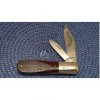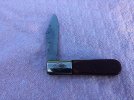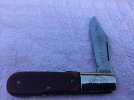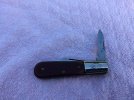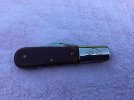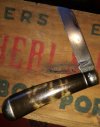-
The BladeForums.com 2024 Traditional Knife is available! Price is $250 ea (shipped within CONUS).
Order here: https://www.bladeforums.com/help/2024-traditional/
You are using an out of date browser. It may not display this or other websites correctly.
You should upgrade or use an alternative browser.
You should upgrade or use an alternative browser.
Your newest addition:traditionals of course!
- Thread starter Will Power
- Start date
Will Power
Gold Member
- Joined
- Jan 18, 2007
- Messages
- 33,576
Yes, and an impressive transition from blade to spring, all the more so as it's a curved blade.
- Joined
- Mar 31, 2016
- Messages
- 1,649
I got two Barlows on the way that I picked up over the weekend.
I know the case is dated 1940-1964 but does anybody have an idea on the Dimond Edge?
I know the case is dated 1940-1964 but does anybody have an idea on the Dimond Edge?
Attachments
- Joined
- May 2, 2016
- Messages
- 746
I got two Barlows on the way that I picked up over the weekend.
I know the case is dated 1940-1964 but does anybody have an idea on the Dimond Edge?
Hey Trevor,
Imperial started using the Diamond Edge marque in 1967, so it would be some time after that. Looks like it's in great shape.
John
- Joined
- May 27, 2015
- Messages
- 1,710
Sorry no info from me but I do love those Rat Tale bolsters
Sweet sheep's foot knife.
Thanks, I kinda like it too. I was hoping for a Lambsfoot but its not quite on par .
Last edited:
5K Qs
Gold Member
- Joined
- Jul 20, 2014
- Messages
- 15,808
Congrats, Dave!View attachment 725134 I got this a few days ago. It looks like it reads Richards Sheffield England ( my first ). Nothing fancy but I do like it. Any info about it would be greatly appreciated. Thanks.

Are the handles made of horn, or are they some kind of synthetic? Looks like horn to me, but I thought Richards stuck to making very economical knives with celluloid covers.
I think I read somewhere that Richards in Sheffield was related to (founded by?) men with connections to the Richartz company in Solingen, Germany, but they "anglicized" the name shortly before WWII. But I can't come up with a reliable source for that info at the moment.
OK, Google led me to something from a Bernard Levine column in Knife World (Number 416, August 2012); I hope this link works (if it does, it downloads an RTF document to your computer):
svalbardrepublic.org/z-wi-working-bak/wiaug12-416.rtf
- GT
- Joined
- May 27, 2015
- Messages
- 1,710
Thanks Gary, I hoped the handles were horn. Kind of looks and feels like it but from the info I've seen and from what you and Jack tell me they made budget blades and used celluloid.Congrats, Dave!I also know little about your knife, but it looks good, and who can resist that lamp post on the tang stamp?
Are the handles made of horn, or are they some kind of synthetic? Looks like horn to me, but I thought Richards stuck to making very economical knives with celluloid covers.
I think I read somewhere that Richards in Sheffield was related to (founded by?) men with connections to the Richartz company in Solingen, Germany, but they "anglicized" the name shortly before WWII. But I can't come up with a reliable source for that info at the moment.
OK, Google led me to something from a Bernard Levine column in Knife World (Number 416, August 2012); I hope this link works (if it does, it downloads an RTF document to your computer):
svalbardrepublic.org/z-wi-working-bak/wiaug12-416.rtf
- GT

5K Qs
Gold Member
- Joined
- Jul 20, 2014
- Messages
- 15,808
Dave, if it is horn, it's REAL purdy IMHO!!Thanks Gary, I hoped the handles were horn. Kind of looks and feels like it but from the info I've seen and from what you and Jack tell me they made budget blades and used celluloid.. I can't get that link to open on my phone. I'll try on the tablet when I get home from work. Thanks again.


I'll paste in the most relevant part of the document I downloaded, in case the link doesn't work for you. (The document I downloaded had no actual images in it, just the "PICTURE #" placeholders.):
WHUT IZZIT
by Bernard Levine
www.knife-expert.com
I am fond of simple metal-handle pocketknives with fancy handle artwork that tells, or at least refers to, interesting stories. Sometimes these are advertising knives, such as the Hudson’s Bay Company electrician knife featured last month. Often they are commemorative knives, depicting famous people or significant events. Examples include the Father Kolping jack knife featured in the December 2010 issue, and the ten Russian military officers pen knife featured in February 2011. And sometimes they are souvenir knives, sold at an historic site, or upon an historic occasion.
Here is an example of the souvenir type. It is unusual as a knife, as well as for the history it reveals.
PICTURE 1
It is a letter opener pen knife, with the spring extending out one end, forming the letter opener, and a folding blade in the other end. The folding blade is a clip point. It is tang stamped in an old-looking sans serif typeface RICHARTZ/ CUTLERY Co./ GERMANY.
PICTURE 2
Gebruder Richartz & Soehne (Richartz Brothers & Sons) opened a factory in Solingen-Ohligs, Germany, circa 1900. It specialized in high-volume low-priced pocketknives and razors, and grew to be a successful enterprise. Members of the family began a branch operation in Sheffield, England, in 1932. During World War II the branch became a separate company, Richards Brothers. After the war, Richards built a new large factory on Moore Street in Sheffield, and became the most profitable pocketknife firm in Britain.
Both Richartz and Richards were licensed to make Elosi patent handles, pressed sheet steel shells wrapped in colorfully decorated sheet celluloid. The Ernst Loehr Otto Stiehl patent dated from 1934 in Germany (1936 in the U.S.). Imperial Knife Co. of Providence, R.I., held the U.S. license for this patent, one of the most profitable inventions in cutlery history. In 1975 Imperial took over Richards of Sheffield, but could not run it profitably; it was sold in 1982, demolished in 1985. Meanwhile Richartz in Germany continued to operate successfully.
- GT
- Joined
- May 27, 2015
- Messages
- 1,710
Thanks for info Gary. It seems to be a decent knife, But I wish I would have just put that money towards a Lambsfoot. Live and learn I guess.Dave, if it is horn, it's REAL purdy IMHO!!
I'll paste in the most relevant part of the document I downloaded, in case the link doesn't work for you. (The document I downloaded had no actual images in it, just the "PICTURE #" placeholders.):
WHUT IZZIT
by Bernard Levine
www.knife-expert.com
I am fond of simple metal-handle pocketknives with fancy handle artwork that tells, or at least refers to, interesting stories. Sometimes these are advertising knives, such as the Hudson’s Bay Company electrician knife featured last month. Often they are commemorative knives, depicting famous people or significant events. Examples include the Father Kolping jack knife featured in the December 2010 issue, and the ten Russian military officers pen knife featured in February 2011. And sometimes they are souvenir knives, sold at an historic site, or upon an historic occasion.
Here is an example of the souvenir type. It is unusual as a knife, as well as for the history it reveals.
PICTURE 1
It is a letter opener pen knife, with the spring extending out one end, forming the letter opener, and a folding blade in the other end. The folding blade is a clip point. It is tang stamped in an old-looking sans serif typeface RICHARTZ/ CUTLERY Co./ GERMANY.
PICTURE 2
Gebruder Richartz & Soehne (Richartz Brothers & Sons) opened a factory in Solingen-Ohligs, Germany, circa 1900. It specialized in high-volume low-priced pocketknives and razors, and grew to be a successful enterprise. Members of the family began a branch operation in Sheffield, England, in 1932. During World War II the branch became a separate company, Richards Brothers. After the war, Richards built a new large factory on Moore Street in Sheffield, and became the most profitable pocketknife firm in Britain.
Both Richartz and Richards were licensed to make Elosi patent handles, pressed sheet steel shells wrapped in colorfully decorated sheet celluloid. The Ernst Loehr Otto Stiehl patent dated from 1934 in Germany (1936 in the U.S.). Imperial Knife Co. of Providence, R.I., held the U.S. license for this patent, one of the most profitable inventions in cutlery history. In 1975 Imperial took over Richards of Sheffield, but could not run it profitably; it was sold in 1982, demolished in 1985. Meanwhile Richartz in Germany continued to operate successfully.
- GT
black mamba
Gold Member
- Joined
- Oct 21, 2009
- Messages
- 23,571
I found another Winchester Cartridge Series large stockman, this time in a beautiful butterscotch colored bone.


paulhilborn
Gold Member
- Joined
- Mar 22, 2006
- Messages
- 14,483
That's a BEAUTY Jeff

- Joined
- Sep 28, 2015
- Messages
- 567
- Joined
- Nov 30, 2016
- Messages
- 3,089
Very nice Jeff! I agree, the bone color is a beauty.I found another Winchester Cartridge Series large stockman, this time in a beautiful butterscotch colored bone.

- Joined
- Nov 30, 2016
- Messages
- 3,089
Really interesting look. Is that a mod you did?
- Joined
- Sep 28, 2015
- Messages
- 567
Indeed. I reshaped it, charred it to bring out some of the grain and give it character. Stained with dark walnut, then hand rubbed with a thinned linseed oil, followed by a buffed wax coat.
- Joined
- Nov 30, 2016
- Messages
- 3,089
Indeed. I reshaped it, charred it to bring out some of the grain and give it character. Stained with dark walnut, then hand rubbed with a thinned linseed oil, followed by a buffed wax coat.
Nice job! It looks great!

